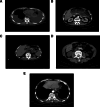Comprehensive treatment strategy for pancreaticopleural fistula: A rare case report and review of 91 cases
- PMID: 40184110
- PMCID: PMC11709174
- DOI: 10.1097/MD.0000000000041184
Comprehensive treatment strategy for pancreaticopleural fistula: A rare case report and review of 91 cases
Abstract
Rationale: Pancreaticopleural fistula (PPF) is a rare but serious complication of pancreatic disease, typically resulting from the rupture of a pancreatic pseudocyst or ductal injury. The condition often leads to misdiagnosis due to its nonspecific clinical manifestations, including dyspnea and chest pain.
Patient concerns: A 61-year-old male with a history of alcohol and tobacco use presented with severe dyspnea, chest pain, and cough. He had been diagnosed with acute pancreatitis 9 months prior and intermittently experienced upper abdominal pain and distension post-treatment.
Diagnoses: PPF.
Interventions: The patient underwent thoracic drainage, nasopancreatic duct drainage, and pancreatic duct stent placement, along with parenteral nutrition and somatostatin therapy.
Outcomes: Treatment resulted in resolution of pleural effusion and pseudocyst. The patient had no recurrence during a 5-year follow-up period.
Lessons: This case demonstrates the effectiveness of a comprehensive treatment strategy combining thoracic and pancreatic drainage for PPF. Long-term follow-up is crucial for monitoring recurrence and assessing treatment efficacy. Future research should focus on optimizing treatment plans, particularly regarding the best timing for intervention and improving long-term outcomes.
Copyright © 2025 the Author(s). Published by Wolters Kluwer Health, Inc.
Conflict of interest statement
The authors have no conflicts of interest to diclose.
Figures


Similar articles
-
[Pancreatico-pleural fistula in chronic pancreatitis with necrosis of the pancreatic tail].Dtsch Med Wochenschr. 2004 Aug 20;129(34-35):1802-5. doi: 10.1055/s-2004-829032. Dtsch Med Wochenschr. 2004. PMID: 15314743 German.
-
Pancreaticopleural fistula.Pancreas. 2009 Jan;38(1):e26-31. doi: 10.1097/MPA.0b013e3181870ad5. Pancreas. 2009. PMID: 19106743 Review.
-
Pancreaticopleural fistula causing recurrent bilateral pleural effusions: A case report.Medicine (Baltimore). 2024 Dec 20;103(51):e41029. doi: 10.1097/MD.0000000000041029. Medicine (Baltimore). 2024. PMID: 39705491 Free PMC article.
-
Pancreaticopleural fistula: an overlooked entity.Asian Cardiovasc Thorac Ann. 2014 Jan;22(1):98-101. doi: 10.1177/0218492312474453. Epub 2013 Jul 26. Asian Cardiovasc Thorac Ann. 2014. PMID: 24585655
-
Pancreaticopleural fistula causing pleural effusion: a case report and review of the literature.J Med Case Rep. 2024 Mar 29;18(1):131. doi: 10.1186/s13256-024-04457-8. J Med Case Rep. 2024. PMID: 38549170 Free PMC article. Review.
References
-
- Chawla G, Niwas R, Chauhan NK, Dutt N, Yadav T, Jain P. Pancreatic pleural effusion masquerading as right sided tubercular pleural effusion. Monaldi Arch Chest Dis. 2019;89:3. - PubMed
Publication types
MeSH terms
LinkOut - more resources
Full Text Sources
Medical

